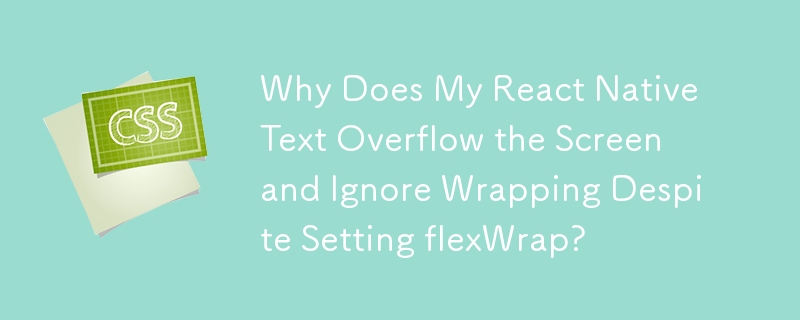 Web Front-end
Web Front-end
 CSS Tutorial
CSS Tutorial
 Why Does My React Native Text Overflow the Screen and Ignore Wrapping Despite Setting flexWrap?
Why Does My React Native Text Overflow the Screen and Ignore Wrapping Despite Setting flexWrap?
Why Does My React Native Text Overflow the Screen and Ignore Wrapping Despite Setting flexWrap?

React Native Text Overflows Screen and Ignores Wrapping
In React Native applications, it's possible to encounter a situation where text overflows the screen and refuses to wrap within a designated space. This issue often arises due to misconfiguration or improper usage of flexbox properties.
Problem Statement
The concern involves a React Native element containing two nested containers and a Text component with a defined number of lines. Despite specifying flexWrap on the Text component, the text spills over the screen instead of wrapping within the allocated space.
Root Cause
The root of this problem lies in the lack of proper flex settings within the parent container. To ensure correct text wrapping, specific flex properties must be applied to the parent container, allowing the child elements to utilize the available space efficiently.
Possible Solution
To resolve this issue and confine the text within the allocated space, consider the following steps:
- Remove Width Constraint: Remove the "width" property from the descriptionContainerHor style. Relying on flexbox will ensure dynamic adjustment to different screen sizes.
- Utilize Flex: Set the flex property to 1 on the parent container, allowing it to fill the remaining space after accommodating its siblings.
- Enable Text Wrapping: Ensure that flexWrap is set to "wrap" on the Text component. This allows the text to break into multiple lines within the available width.
- Exclude Flex Shrink: Add the property flexShrink with a value of 1 to the descriptionContainerHor style. This prevents the container from shrinking below its initial flex dimension, ensuring the text remains visible.
Implementation Example
<code class="javascript">var styles = StyleSheet.create({
container: {
flex: 1,
flexDirection: 'column',
justifyContent: 'flex-start',
},
descriptionContainerVer: {
...
},
descriptionContainerVer2: {
...
},
descriptionContainerHor: {
flex: 1,
flexDirection: 'column',
alignItems: 'center',
justifyContent: 'center',
flexWrap: 'wrap',
flexShrink: 1,
},
descriptionText: {
...
},
});</code>By implementing these adjustments, the text will adhere to the parent container's boundaries while remaining centered within the available space. Addressing the flexbox settings and ensuring correct wrapping enables a responsive and user-friendly interface on various screen sizes.
The above is the detailed content of Why Does My React Native Text Overflow the Screen and Ignore Wrapping Despite Setting flexWrap?. For more information, please follow other related articles on the PHP Chinese website!

Hot AI Tools

Undresser.AI Undress
AI-powered app for creating realistic nude photos

AI Clothes Remover
Online AI tool for removing clothes from photos.

Undress AI Tool
Undress images for free

Clothoff.io
AI clothes remover

Video Face Swap
Swap faces in any video effortlessly with our completely free AI face swap tool!

Hot Article

Hot Tools

Notepad++7.3.1
Easy-to-use and free code editor

SublimeText3 Chinese version
Chinese version, very easy to use

Zend Studio 13.0.1
Powerful PHP integrated development environment

Dreamweaver CS6
Visual web development tools

SublimeText3 Mac version
God-level code editing software (SublimeText3)

Hot Topics
 1653
1653
 14
14
 1413
1413
 52
52
 1304
1304
 25
25
 1251
1251
 29
29
 1224
1224
 24
24
 Stacked Cards with Sticky Positioning and a Dash of Sass
Apr 03, 2025 am 10:30 AM
Stacked Cards with Sticky Positioning and a Dash of Sass
Apr 03, 2025 am 10:30 AM
The other day, I spotted this particularly lovely bit from Corey Ginnivan’s website where a collection of cards stack on top of one another as you scroll.
 Google Fonts Variable Fonts
Apr 09, 2025 am 10:42 AM
Google Fonts Variable Fonts
Apr 09, 2025 am 10:42 AM
I see Google Fonts rolled out a new design (Tweet). Compared to the last big redesign, this feels much more iterative. I can barely tell the difference
 How to Create an Animated Countdown Timer With HTML, CSS and JavaScript
Apr 11, 2025 am 11:29 AM
How to Create an Animated Countdown Timer With HTML, CSS and JavaScript
Apr 11, 2025 am 11:29 AM
Have you ever needed a countdown timer on a project? For something like that, it might be natural to reach for a plugin, but it’s actually a lot more
 HTML Data Attributes Guide
Apr 11, 2025 am 11:50 AM
HTML Data Attributes Guide
Apr 11, 2025 am 11:50 AM
Everything you ever wanted to know about data attributes in HTML, CSS, and JavaScript.
 Why are the purple slashed areas in the Flex layout mistakenly considered 'overflow space'?
Apr 05, 2025 pm 05:51 PM
Why are the purple slashed areas in the Flex layout mistakenly considered 'overflow space'?
Apr 05, 2025 pm 05:51 PM
Questions about purple slash areas in Flex layouts When using Flex layouts, you may encounter some confusing phenomena, such as in the developer tools (d...
 How to select a child element with the first class name item through CSS?
Apr 05, 2025 pm 11:24 PM
How to select a child element with the first class name item through CSS?
Apr 05, 2025 pm 11:24 PM
When the number of elements is not fixed, how to select the first child element of the specified class name through CSS. When processing HTML structure, you often encounter different elements...
 A Proof of Concept for Making Sass Faster
Apr 16, 2025 am 10:38 AM
A Proof of Concept for Making Sass Faster
Apr 16, 2025 am 10:38 AM
At the start of a new project, Sass compilation happens in the blink of an eye. This feels great, especially when it’s paired with Browsersync, which reloads
 In front-end development, how to use CSS and JavaScript to achieve searchlight effects similar to Windows 10 settings interface?
Apr 05, 2025 pm 10:21 PM
In front-end development, how to use CSS and JavaScript to achieve searchlight effects similar to Windows 10 settings interface?
Apr 05, 2025 pm 10:21 PM
How to implement Windows-like in front-end development...



